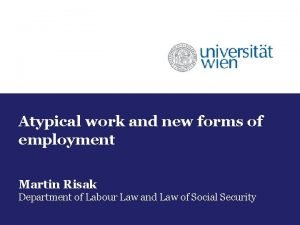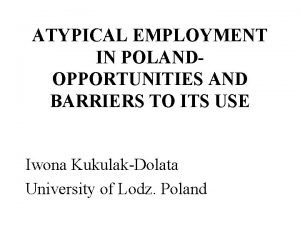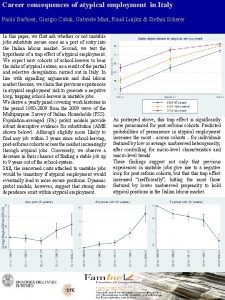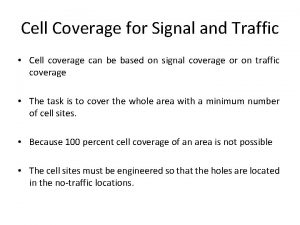Atypical employment and social security coverage a EU




























- Slides: 28

Atypical employment and social security coverage: a EU overview Dr. Koen Vleminckx Component Two- 2016 Training Course “European practices in the Governance, Financial Management and Strategies for a Sustainable Social Security System”

Index üLabour market reforms and flexibility üFlexibility and Atypical Employment § Part-time employment § Temporary employment § Self-employment üProviding social security coverage to atypical workers Page 2

Labour market reforms and flexibility Page 3

LABOUR MARKET REFORMS AND FLEXIBILITY § § Page 4 Labour market flexibility is a multidimensional concept Partialy a result of a need for “numerical flexibility” and high unemployment Several EU countries introduced labour market reforms “at the margin” In doing so, they sought to shelter the core workforce from regulatory changes, shifting the burden of functional adjustment mostly on new entrants in the labour market.

FLEXIBILITY AND ATYPICAL WORK Page 5

FLEXIBILITY AND “ATYPICAL WORK” � A standard employment relationship exists when an individual is in a dependent employment relationship for at least 35 hours weekly and has a permanent employment contract. � Part-time employment is employment with less than 35 hours a week (substantial: 20 hours and more a week; marginal: less than 20 hours a week). � Fixed-term employment exists when the period during which a contract is valid is limited (can be part-time). � Self-employment exists when an individual’s main economic activity is not dependent employment. � Quid informal employment? Page 6

Incidence and evolution of part-time employment (% of employment) Source: Eurostat Page 7 2007 2010 2013 Netherlands 46. 3 48. 3 49. 8 Germany 25. 4 25. 5 26. 7 UK 24. 1 25. 7 25. 6 Denmark 23. 0 25. 6 24. 7 France 17. 2 17. 6 18. 1 Italy 13. 4 14. 8 17. 6 Spain 11. 4 12. 9 15. 7 EU-27 17. 6 18. 6 19. 7

Incidence and evolution of involuntary part-time employment (% of part-time employment) Source: Eurostat Page 8 2007 2010 2013 Netherlands 5. 1 5. 7 9. 9 Germany 22. 6 21. 9 15. 6 UK 10. 6 Denmark 13. 4 15. 6 18. 3 France 31. 5 31. 7 39. 3 Italy 39. 5 50. 5 63. 0 Spain 33. 3 50. 1 63. 3 EU-27 22. 4 26. 7 29. 4

Title Page 9

Share (%) of temporary employment in total dependent employment Source: OECD Page 10 1990 2000 2012 UK 5 7 6 Denmark 11 10 9 France 11 16 15 Germany 11 13 14 Italy 5 10 14 Spain 30 32 24 EU-21 10 13 14 OECD 10 11 12

Share (%) of temporary employment in total dependent employment, 15 -24 Source: OECD Page 11 1990 2000 2012 UK 10 13 15 Denmark 30 30 21 France 38 55 55 Germany 34 52 54 Italy 11 26 53 Spain 66 69 63 EU-21 26 36 39 OECD 20 24 24

Self-employment rate across selected EU Countries, 2005 -2014 Page 12

Percentage change employment and selfemployment rate across selected EU Countries, 2005 -2014 Page 13

Male and female self-employment rate, EU Countries, 2013 Page 14

The issue of dependent self-employment” Dependent self-employment is defined as a working relationship where the worker is formally self-employed yet under conditions of work similar to those of dependent employees. Dependent self-employment more frequently occurs in construction, transport, insurance and accounting, business services, architecture and the creative sector. Page 15

The issue of dependent self-employment” Example 1: A truck driver who owns his (only) truck and runs a trucking company, but works only for one forwarding company. The latter determines the work schedule and the appearance of the trucks, etc. The self-employed truck driver bears the cost and risk of the functioning of the truck, only earns when s/he works (i. e. no paid holidays) and is responsible for social insurance contributions. Example 2: Tied agents in the insurance industry are self-employed insurance agents selling insurance products of only one insurance company. They usually appear under the logo of the respective insurance company, although they are self-employed. They have a binding contract forbidding them to sell insurance products from other companies. Page 16

Little numerical data concerning dependent self-employment UK: Burchell et al. (1999) find that 5 per cent of those in employment are individuals who contract to supply their own personal services to an employer without having a contract of employment yet are economically dependent on the employer’s business to some degree given that they derive a substantial part of their income from this particular work. Germany: Dietrich (1996) affirms that around 3 per cent of the labour force work in the grey zone between self-employment and employment. Italy: Berton et al. (2005) states that there were more than half a million “parasubordinati” (i. e. self-employed without employees working for one company) representing 2. 5 % of those in employment. Austria: around 1. 1 per cent of the labour force worked as self-employed for only one employer and were bound by the instructions of the employer or contract partner (in terms of labour time and methods) in 2001 (Statistik Austria 2002). Page 17

Providing social security coverage to atypical workers Page 18

Challenges of covering atypical work Ø Design challenges Ø Administrative challenges Ø Challenge of compliance Page 19

Design challenge Main challenge: extending social protection, and particularly social insurance, to atypical workers by providing more inclusive coverage through the main social insurance schemes or by the creation of specific social security regimes. § Social security coverage often depends on employment status § Social insurance schemes are often complex and fragmented Page 20

Ideal-typical models of Social Insurance

Ideal-typical models of Social Insurance

Administrative challenges Formal employment Self-employed One client ? No Yes Selfemployed ? Dependent selfemployemt Yes No Temporary employment Dependent employment Yes Temporary ? No Less than 35 hours? Yes Less than 35 hours? No Regular selfemployment Page 23 Temporary Parttime employment Part-time employment Typical employment

Coverage of “atypical work” � Part-time employment: Unrestricted coverage by citizenship based schemes, while in insurance based schemes coverage uncertain as entitlement can depend on the number of hours worked , the income earned, or contributions paid. In insurance based systems lower earnings and lower contributions lead to lower benefits. Sometimes corrected through social pooling and subsidies. � Fixed-term employment: Full coverage by citizenship based schemes, even during periods of unemployment. In contributory insurance based schemes no guarantee of continued insurance, although continued insurance is occasionally provided for those covered by unemployment insurance etc. � Self-employment: Full coverage by citizenship based schemes. In some countries categorical social insurance for the self-employed is in place, but not always and not for all social risks. Different earnings concept (gross income – costs = profit), irregular, different timing. Page 24 � Dependent self-employed: The social rights of dependent self-employed are sometimes regulated through a legal hybrid category between genuine self-employment and ‘standard’ dependent employment (Italy, Austria and Germany). If such a legal hybrid category does not exist, their social protection rights are either similar to those of genuine self-employed or can be derived from universal benefits for all inhabitants. In other systems they are identified as so-called “phantom self-employed” and complied to coverage as employee through the “employer” from which they are depending.

Informal employment � Employment deficit: People cannot find work or business opportunities in the formal economy � Social Protection Deficit: Even though the workers in the informal sector are most in need of social protection, they are unable to access formal schemes owing to membership and contribution issues. � Rights deficit: People in informal employment are more vulnerable for the violation of other rights � Information deficit: Very difficult to monitor the quantity and quality of informal employment Page 25

Providing coverage for informal workers � Pragmatic approach: Create a separate framework within the existing schemes to accommodate these workers, tailor made to suit their needs. � Rights approach: Bring informal workers within the legal framework to be reistred, recognized and protected. � Information deficit: Research needed to establish categories of informll-sector workers in order to be able to determine relevant aspects such as contribution capacit, collection of contributions, and distribution of benefits. Page 26

FLEXICURITY IN THE EU Adoption by Member States § Page 27 The flexicurity concept was adopted by the Council of Employment Ministers of the EU in December 2007 following an intensive dialogue with Member States and a strong involvement of social partners.

FLEXICURITY IN THE EU 4 components: § § Page 28 Flexible and reliable contractual arrangements (from the perspective of the employer and the employee) through modern labour laws, collective agreements and work organisation; Comprehensive lifelong learning (LLL) strategies to ensure the continual adaptability and employability of workers, particularly the most vulnerable; Active labour market policies (ALMP) that help people cope with rapid change, reduce unemployment spells and ease transitions to new jobs; Modern social security systems that provide adequate income support, encourage employment and facilitate labour market mobility: unemployment benefits, pensions and healthcare.
 Private securty
Private securty Atypical pneumonia
Atypical pneumonia Atypical bacteria
Atypical bacteria Nodular melanoma
Nodular melanoma Typical chest pain
Typical chest pain Atypical bacteria
Atypical bacteria Atypical bacteria
Atypical bacteria What is national provider identifier number
What is national provider identifier number Atypical psychology definition
Atypical psychology definition Atypical clips
Atypical clips Atypical antipsychotics drugs
Atypical antipsychotics drugs Atypical workers
Atypical workers Chlorpromazine
Chlorpromazine Sternal angle
Sternal angle Atypical pneumonia
Atypical pneumonia Atypical pneumonia
Atypical pneumonia Atypical odontalgia
Atypical odontalgia Atypical behavior
Atypical behavior Benign febrile convulsion
Benign febrile convulsion Water balance regulation
Water balance regulation Chapter 26 fluid electrolyte and acid-base balance
Chapter 26 fluid electrolyte and acid-base balance Atypical cartilaginous tumor
Atypical cartilaginous tumor Social thinking and social influence in psychology
Social thinking and social influence in psychology Social thinking social influence social relations
Social thinking social influence social relations Wireless security in cryptography and network security
Wireless security in cryptography and network security Security policy and integrated security in e-commerce
Security policy and integrated security in e-commerce Osi model security architecture
Osi model security architecture Security guide to network security fundamentals
Security guide to network security fundamentals Explain about visa international security mode
Explain about visa international security mode




















































